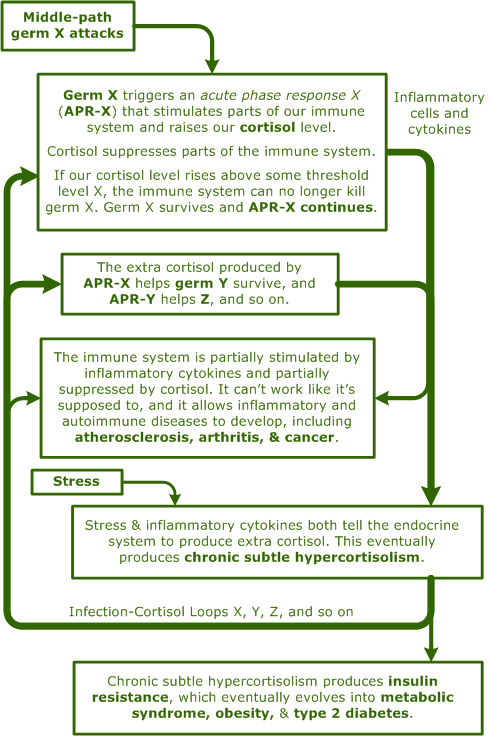The falling apart syndrome
I don't think anyone ever dies from old age--most of us are killed by middle-path germs before we get very old.
According to one theory of aging, our cells have counters called telomeres that limit how many times each cell can replace itself. Some researchers believe that we would run out of telomeres and die at about 115, even if nothing else was wrong with us.
What happens though, is that we start to fall apart long before we run out of telomeres. Some of us become asthmatic, develop acne, and start to have migraine headaches while we are still in out teens. By our thirties, many of us are overweight and we can't run or swim as well as we did a few years earlier. Our health goes downhill at an accelerating rate as we get into our forties and beyond. On www.cpnhelp.org, they call this phenomenon the falling apart syndrome.
I think the reason we start to fall apart while we are still young can be traced back to infection-cortisol loops.
Infection-cortisol loops. The immune system uses inflammatory cells and chemicals to kill germs, and the endocrine system produces cortisol to protect us from inflammation. The result is an infection-cortisol loop that kills most germs quickly without causing us too much fever or pain. There are only a few germs, like the Ebola virus, that overwhelm the infection-cortisol loop and kill us quickly.
Some germs benefit from the extra cortisol more than they are harmed by the inflammatory cells and chemicals. These germs cause chronic infections that keep us in a state of mild inflammation and mild hypercortisolism year after year. In The Potbelly Syndrome we called these germs "middle-path" germs because we can't kill them and they can't kill us.
To be more specific, middle-path germs can't kill us right away. They do kill us, but they do it slowly and painfully; they do it by making us old. The drawing below shows what happens each time we are exposed to a new middle-path germ.

When we pick up a new middle-path infection, we usually live pretty much as we did before, but we have slightly higher levels of inflammation and cortisol. We eat a little more, we sleep a little less. We don't get as much pleasure out of exercise so we do a little less of it. Our quality of life decreases slightly, but middle-path infections usually don't harm us enough to make us remember the week or the month when they started.
Since our cortisol is a little higher than it was before, our immune system won't be quite as effective as it was, and we will be more susceptible to the next germ that we encounter. This is pretty complicated stuff, but the drawing below tries to show what happens as we get older in a world full of germs.

Most middle-path infections last a lifetime, so our "infectious burden" increases every time we get a new one. Since each infection makes us more susceptible to the next one, we pick up infections at an ever-accelerating rate as we age. Similarly, our health declines at an ever-accelerating rate. This is the falling apart syndrome.
A good question. An observant reader might wonder why we evolved a system that is guaranteed to cripple and kill us in the long run. The full answer to this question fills books, but I can summarize it briefly.
Germs are always evolving, and they can evolve faster than we can. Mother Nature had to come up with a germ-killing system that would keep us alive and active long enough to raise children. She succeeded pretty well--the infection-cortisol loop allows most of us to thrive until we are in our Forties. Mother nature loses interest in us after that, and we are on our own.
More information on infections, cortisol, and aging
Infection-cortisol loops are discussed briefly in Chapters 3 and 17 of The Potbelly Syndrome.
To see a list of the diseases linked to just one common germ, take a look at www.potbellysyndrome.com⁄attach⁄CPN.pdf.
Da Prato RA, Rothschild J. The AIDS virus as an opportunistic organism inducing a state of chronic relative cortisol excess: therapeutic implications. Med Hypotheses. 1986 Nov;21(3):253-66.
Ewald PW. Evolution of virulence. Infect Dis Clin North Am. 2004 Mar;18(1):1-15. Review.
http:⁄⁄pubs.niaaa.nih.gov⁄publications⁄arh26-4⁄257-263.pdf. Alcohol and immune suppression.
Rupprecht HJ, Blankenberg S, Bickel C, Rippin G, Hafner G, Prellwitz W, Schlumberger W, Meyer J; AutoGene Investigators. Impact of viral and bacterial infectious burden on long-term prognosis in patients with coronary artery disease. Circulation. 2001 Jul 3;104(1):25-31.
Wick G, Berger P, Jansen-Durr P, Grubeck-Loebenstein B. A Darwinian-evolutionary concept of age-related diseases. Exp Gerontol. 2003 Jan-Feb;38(1-2):13-25. Review.
